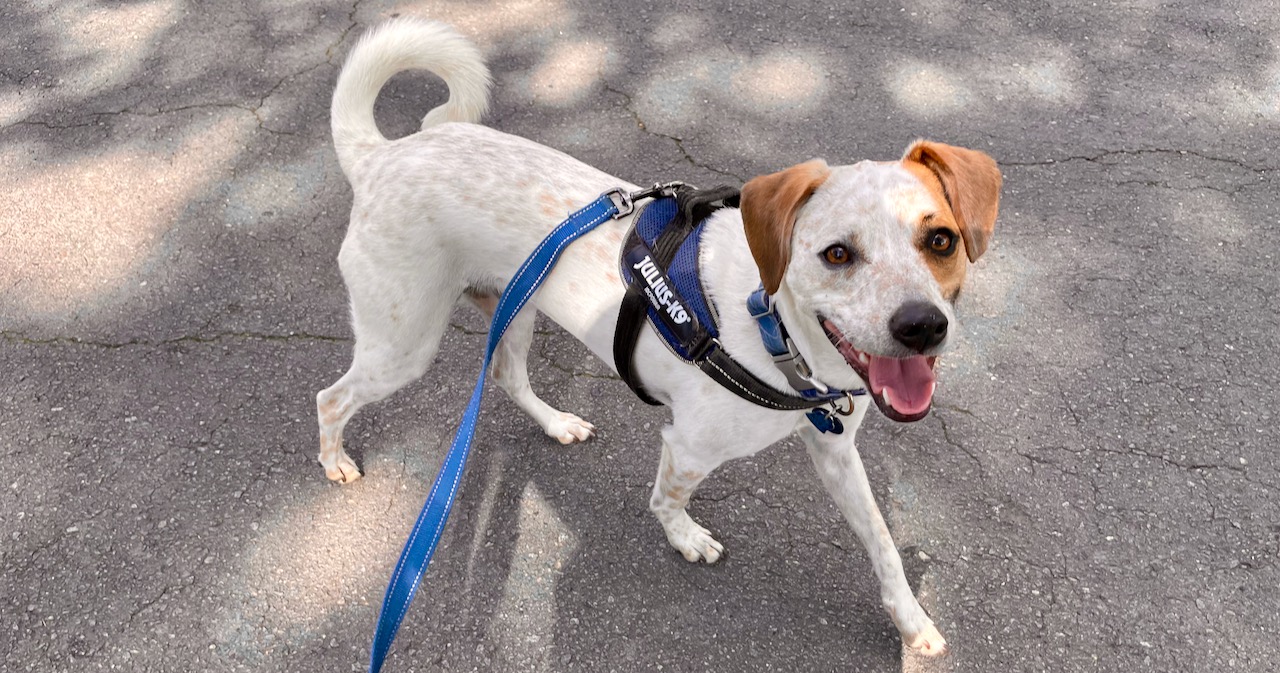Emotional support dogs have become a recent fascination for many people. Everyone wants to know how they get their dog certified and what privileges come with it. I can’t blame them because I become more stressed whenever I must leave my dogs at home.
So I decided to look more into EDSs and where they can go legally. But before I share what I found, let’s define “emotional support dog” to ensure everyone’s on the same page.
What is an Emotional Support Dog?
Emotional support dogs refer to domesticated dogs capable of bringing their owner stability and comfort. In other words, they help people with mental health conditions deal with triggering circumstances.
Some conditions associated with ESDs are PTSD, depression, anxiety, and phobias. ESDs seem to have a sizable impact on how well people with these conditions can manage. It’s just another reason why animals continue to be the best!
But not any dog can become an ESD. There’s a lengthy process associated with becoming an emotional support animal. Luckily, it doesn’t require additional training for your dog but is rather more about the owner’s condition.
It’s much different than what you’d need to get them certified as service or psychiatric service dogs. Service dogs often assist people with physical limitations, while PSDs help people with more severe mental disabilities. As you can imagine, these pups require extensive training to help their owners do specific tasks.
If you want to read more about the ESD certification process, check out this article. It covers everything a person may need to get their dog certified as an ESD.
3 Places You Can Take Emotional Support Dogs
If your dog does get an ESA certification, they gain certain access privileges. Basically, your canine can go places other “regular” dogs can’t enter. Here’s an overview of some new possibilities that would open up to an ESD:
1. Apartments and Other Residential Housing
I don’t know about you, but finding pet-friendly housing is often difficult in my area. But it no longer becomes an issue when your dog is ESA-certified. Under the Fair Housing Act, ESAs can’t be denied entry into residential housing if they alleviate a tenant’s disability.
As a result, an ESD is no longer a pet in the law’s eyes. So landlords can no longer make you pay a pet deposit for them, saving owners quite a bit of money. In certain areas, pet despots can cost several hundred dollars per animal.
These fees will only be waived if you provide an official request and an ESA letter. Otherwise, the building will view your dog as any old pet. You’ll then have to pay the outlandish fees for having a dog inside your home.
But the one area where being ESD doesn’t save money is moving out costs. For instance, an ESD who causes damage to the apartment isn’t exempt from owning it. The owner will be fully responsible for paying any required repairs.
Therefore, I’d recommend offering various toys or other activities to keep them busy. Boredom can cause even the most well-behaved pup to act a little wild. So figure out what your dog likes to do in their free time.
2. College Dorm Rooms and Other Housing
One of the worst parts about going to college is not bringing your pets. Honestly, I was distraught about leaving my dog behind at home. I considered (not seriously) skipping college altogether over this issue.
However, if your dog is an ESD this problem doesn’t exist. The Fair Housing Act will save your life and allow them to live in your dorm room or other university housing. But have all the necessary paperwork (ESA letter from a health professional).
This letter must dictate how your animal alleviates a specific condition. If not, your university can deny your dog’s presence in dorm rooms or other housing. So it’s best to ensure you give them no choice with all the necessary items.
In most cases, colleges and universities often aren’t too excited about letting this happen. They’ll do whatever it takes to ensure this placement doesn’t happen. So be prepared to make sure you can always have your dog around, even when away at school.
3. Residential Public/Common Areas
ESDs will have special privileges around your housing’s public and common areas. So your dog can adventure into the lobby, lounge, elevator, and other similar places. But it’s vital to have them trained and comfortable with these situations.
After all, you don’t want to make any neighbors uncomfortable by your dog. I’d pay special attention to understanding recall and sit commands. Both are crucial to diffusing potential issues that could occur in residential common areas.
Lastly, please keep them on leash within these areas. It doesn’t matter if they’re an ESA; some people aren’t comfortable with encountering dogs. Don’t make things worse by letting yours off-leash in areas where non-ESDs aren’t allowed.
6 Places You Can’t Take Emotional Support Dogs
As you can see, emotional support dogs do have more privileges than regular pets. But it doesn’t mean that there aren’t places where you can’t take them. Here’s a quick look at some common destinations where your ESD simply isn’t allowed:
1. Airplanes
A big misconception about ESA certification is it allows animals to go on planes. This belief isn’t true because airlines don’t have regulations they need to follow about ESAs. Instead, they’ll see your emotional support dog as any other pet.
So anyone who intends to put their ESD on a plane has to follow the regular rules. You’ll have to pay a fee and have them travel in the cargo hold or cabin (if small enough). Don’t forget to contact the airline beforehand to ensure you follow their regulations.
I’d recommend setting up other travel accommodations if they can’t travel in the cabin. I could fill up an entire article with horror stories I’ve heard about dogs traveling in cargo holds.
2. Buses/Trains
Public transportation is another situation that isn’t ESA-friendly. So train or bus rides will have to be without your treasured pup unless there’s a special regulation. However, some public transport does allow small dogs in carriers onboard, but it’s not a requirement.
Given this information, I’d suggest contacting the bus or train company. You don’t want to travel there and have them not allow your pup on the bus/train. It’ll end up being a waste of time for everyone involved.
3. Restaurants/Shops
ESA certification doesn’t allow dogs access to restaurants or shops with no-pet policies. So don’t assume every restaurant/shop will be welcoming to your dog. Now, some will certainly have no issues with it, but they aren’t required.
It’s why I often recommend being overly aware of a place’s policies before going there. You don’t want to cause a raucous by doing something that isn’t allowed. It’s best to ask politely and be cautious to avoid any issues.
4. Hotels/Airbnbs
Hotels and Airbnbs aren’t required to accommodate anyone’s ESA. It’s not a rule or regulation made necessary by the federal government. But of course, some places will be more than happy to let your dog stay there.
It’s just a matter of communicating with them to see whether they’re dog-friendly. It may require an extra fee or sending your dog’s information to them. In some cases, hotels and Airbnb will have weight-limit requirements for pets.
5. Work
Employers have no legal requirement to allow ESD into workplaces. I can see why they wouldn’t want them within their facilities, either. Nothing distracts people more than an adorable dog wandering around and seeking attention.
I certainly wouldn’t get any work done with my dog. But if a person does need their ESD at work, I’m sure they can talk with their boss. I’d imagine some will be more willing to accommodate your specific needs.
Another option would be setting up a work-at-home arraignment. Doing so would allow you to feel less stressed out and have the company of your ESD. Even if you don’t think it’s a possibility, it never hurts to ask and have a conversation.
6. Classrooms
I mentioned earlier how college dorms and housing must make exceptions for ESDs. But this exception doesn’t extend to classrooms. So during classes, your dog has to stay home unless your college permits you.
It’s a bit of a bummer because having your dog around would make classes more fun. I would’ve been less stressed and bored if mine were keeping me company. But it doesn’t seem like it’ll be in the cards for most of us.
Conclusion
Overall, emotional support dogs get more legal leeway compared to traditional pets. These dogs are legally allowed in no-pet apartments/residential housing, college dorms/housing, and residential public/common areas. It’s all made possible by the Fair Housing Act.
But aside from these areas, your ESD won’t be given legal access. So there won’t be special privileges on airlines, buses, trains, hotels, classrooms, or even at work. In these situations, people with ESDs will need to seek permission or look at the rules/regulations.
Anyone with more questions about emotional support dogs leave a post in the comment section. I’ll make sure to answer them as soon as possible. Thanks for reading!



